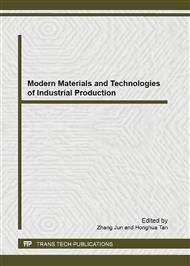p.83
p.87
p.93
p.98
p.104
p.108
p.113
p.120
p.126
Effect of Drawing Tubes without Interoperation Recrystallization Annealing on the Orientation of Boundaries Grain - Orthogonal Direction
Abstract:
The term cold-drawing of tubes refers to forming when the final material (a tube) is formed in a pipe bell and its vertical cross-section is smaller, the tube wall is thinner or thicker and its length is greater. Steel is most commonly the final material. The forming proceeds in a few draws which depend on the final tube dimension. The selection of relative reduction for particular diameters plays an important role because an unbalanced reduction causes stress, and therefore also deformation or cracks during drawing. The technological parameters are: rolling temperature, de-burring of tube ends, the reduction, which determines the dimensions of the forming tools, the optimal chemical modification, the speed of forming on the drawbenches, and the method of tube drawing.
Info:
Periodical:
Pages:
104-107
Citation:
Online since:
September 2013
Authors:
Price:
Сopyright:
© 2013 Trans Tech Publications Ltd. All Rights Reserved
Share:
Citation:


